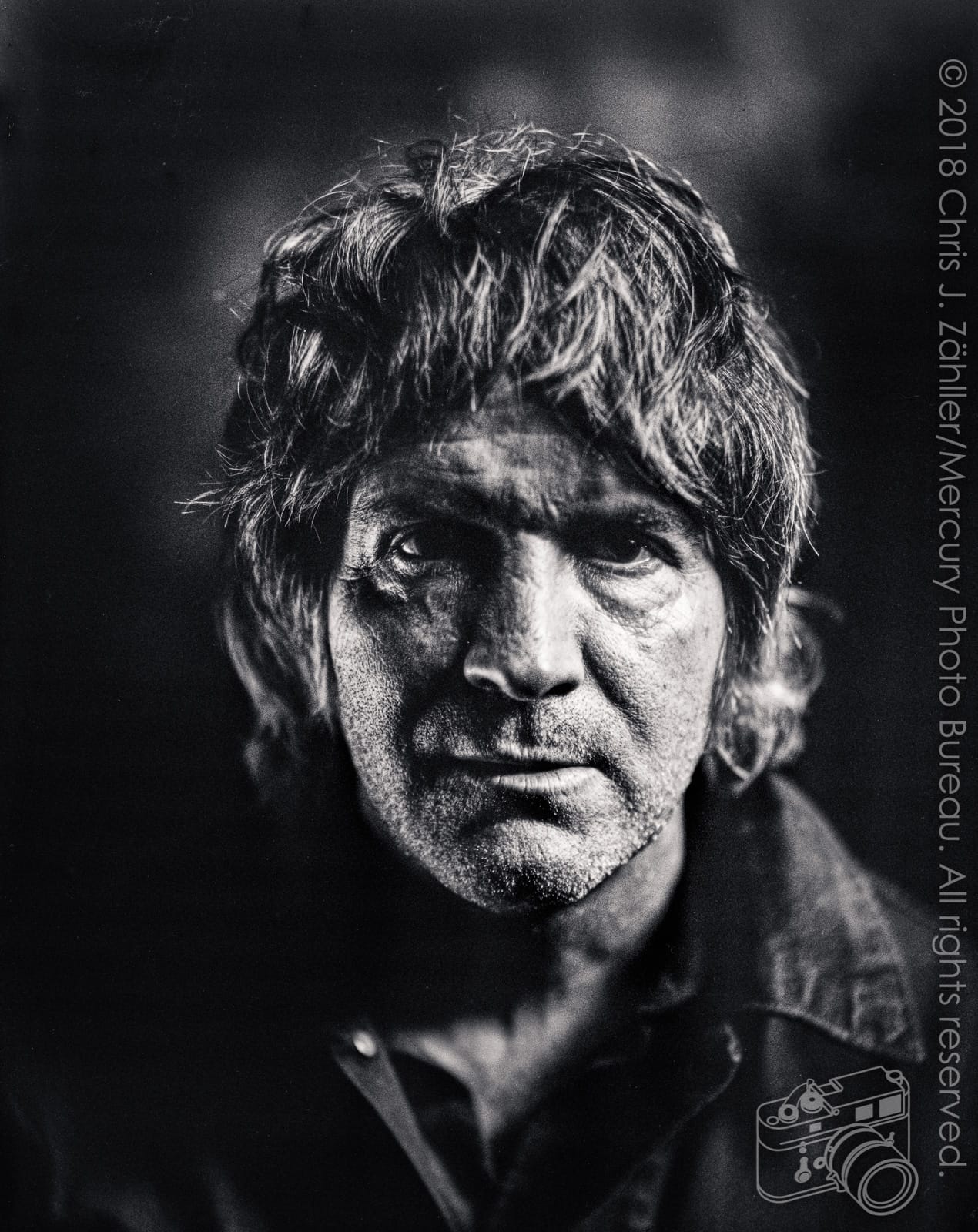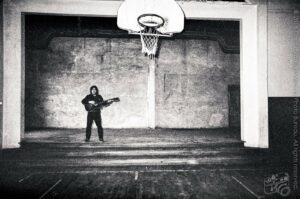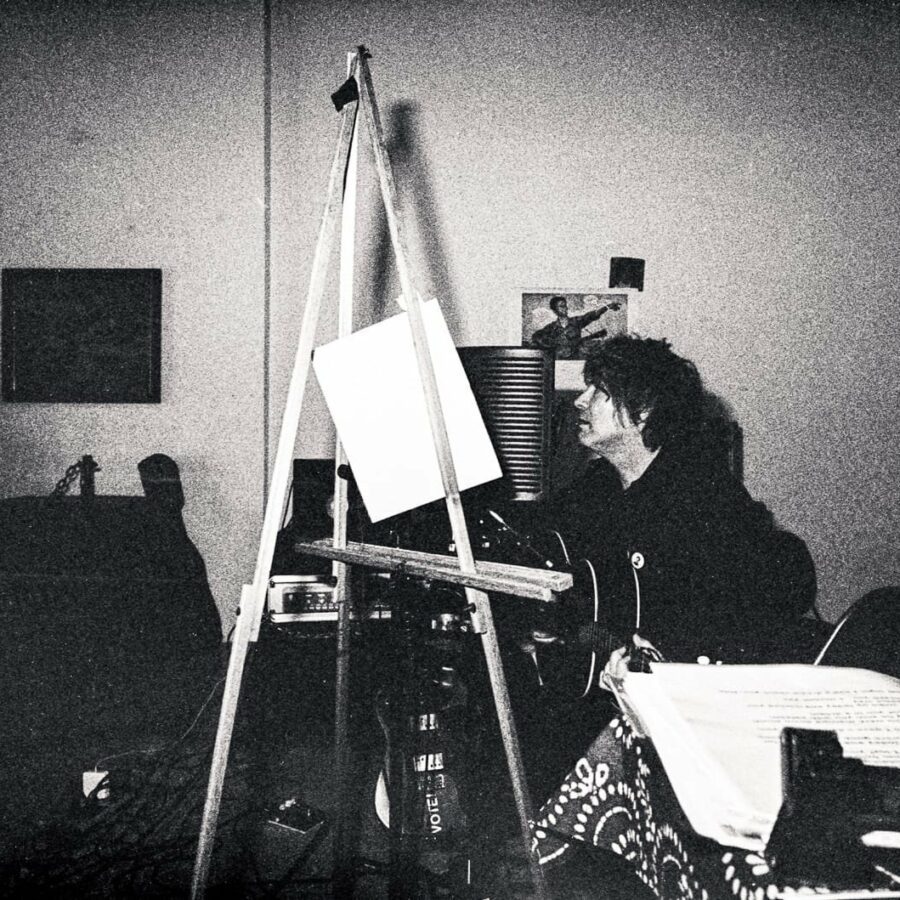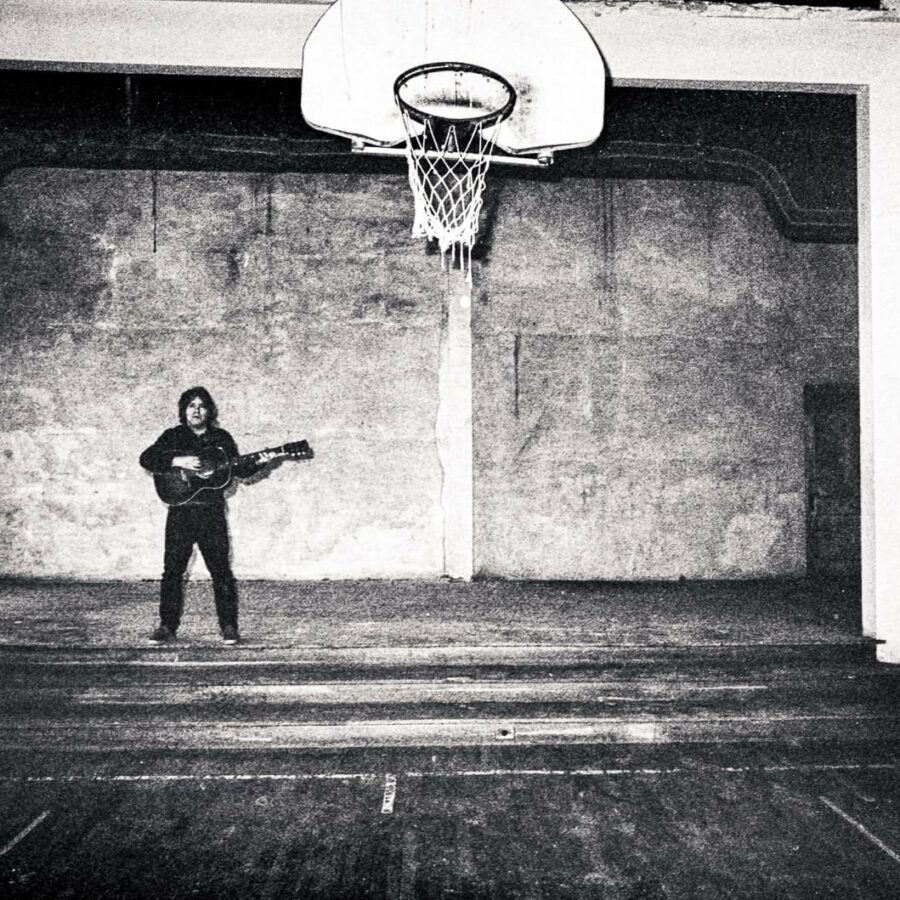
Tim Easton: Exposition Interview & Gallery
The Interview
Keeping It Simple
I drove to Okemah in to see folk singer and songwriter Tim Easton. Easton was on the first leg of a multi-city recording tour for his new album Exposition. After we had lunch at the Hen House Café I took some pictures of him working in his makeshift studio at the Okfuskee County History Center, and then he very competently art-directed an impromptu photo shoot that used the remaining frames on my roll of Tri-X.
We then sat down for a short interview, following which Easton sat for a formal portrait in the style of my OKIE-X project. The weather was threatening to turn bad, so I dismantled my photo studio while he continued tracking songs. Easton helped me schlep the gear to the car and we said our goodbyes, each wishing the other safe travels.
The following is the interview transcript.
Mercury Photo BureauTim — thumbnail bio? How’d you get to be in this thankless, remuneratively skint vocation?
Tim EastonUm I don’t know what you’re talking about; it’s just a prize of wealth and riches, at least emotionally […]. Well, I was born in upstate New York, and my dad worked for Goodyear, which is why I kinda grew up in Akron, Ohio. And then my brothers played guitar — I’m the youngest of four brothers and two sisters, two very important sisters — and those brothers taught me about Doc Watson and old blues music, and that kind of led me to Woody Guthrie […]. And then I ended up — because of Jimmy LaFave — […] coming to Woodyfest for the first time. […] I’d popped through Okemah before, of course, just to check it out, on my many cross-country trips. And then I got to play Woodyfest. And then I got welcomed into the family, and I decided, in order to ensure myself permanent status in this family I would come here and make a record, right here in Okemah — right here in the Okfuskee [County History Center].

MPBWhich brings me to my second question, why the heck are you recording an album here? Although I think you’ve already answered it.
Tim[Laughs] I did, I basically — um, it’s a practical reason, right? I was like, I want to do another ‘field recording’ album!
— my last album was done direct-to-lacquer in Bristol, Virginia, and then I wanted to take to the road and record another album in historical locations. And I’m starting in Okemah primarily because Woody Guthrie is from here, but there’s obviously something else good in the water here, ’cause let’s not forget Mr. John Fullbright is from here, and a lot of great people I’ve met, over the years. So, I basically, I came here to record because I knew I’d be able to find a big space and just use the town vibes to record some of these original songs. And next I’m going to go down to San Antonio, Texas and record where Robert Johnson worked, at the Gunter [Hotel], [Sidenote: The edifice was designed by St. Louis architect John Mauran. Robert Johnson recorded versions of twenty-two of his twenty-nine song catalogue in Room 414 from to .] and then I’m gonna mosey over to Clarksdale, Mississippi [Sidenote: Legend has it that Robert Johnson met the Devil at the intersection of Highway 61 and Highway 49 in Clarksdale. The Devil re-tuned Johnson’s guitar in exchange for his soul. Other versions of the myth posit alternative locations for the legendary meeting place. Some blues fans interpret the lyrics of “Cross Road Blues” to be an account of that meeting. Additionally, Bessie Smith died almost in the nearby Riverside Hotel following an automobile accident on Highway 61. The Mississippi Blues Trail has placed numerous markers for historic blues sites around the city. The Delta Blues Museum, the Sunflower River Blues Festival, and Juke Joint Festivals all call Clarksdale their home.] and work there a little bit too. So this is a field recording project.
MPBOkay, so do you have a name for the album yet?
TimI do; I’m calling the album Exposition. It’s maybe not wise to name an album, and/or do the photoshoots before the album is done because it starts to take on a life of its own. But also, I also — I’ve never done it like this before, where I started a [PledgeMusic] campaign to help raise the money just to help pay for the traveling, and then for the eventual mixing and manufacturing of [the album] to vinyl. But I decided to to give it a name, and exposition
is a word, you know you see it a lot in Europe [about] art exhibits, you know, an exposition of art.
And I got it from a Walt Whitman poem, [Sidenote: Whitman, Walt, “Song of the Exposition” in Leaves of Grass (The Deathbed Edition), (New York, Book of the Month Club by arrangement with Simon and Schuster, ), 148 – 155.] and I, um — just the word itself jumped out, and I thought it’d be a good title for an album. And it means a lot of different things, but right now it’s just about showing what it’s like to be a troubadour recording on the road.

MPBYou keep anticipating my questions. I was gonna ask about the creative fundraising you’ve done for this; you showed me some [disposable] cameras, earlier?
TimYeah, part of the thing I do at Pledgemusic.com is you give incentives away to get people to come with you on this journey […]. [Sidenote: Since this article originally posted the crowdfunding platform PledgeMusic has undergone a very public implosion. Easton issued a statement in ; in it he said If anybody you know wants this album, all they have to do is go to TIMEASTON.COM and write me on the CONTACT page and I can get them vinyl or CD. The digital version is available at my Bandcamp Page. You can listen, stream, or buy it here https://timeaston1.bandcamp.com/album/exposition.
Thanks for spreading the word.
] This is the first time I’ve invited people to come along while I do it. The [disposable] cameras are just a thing I offer, you know — you donate a certain monetary thing, you know, and you get a camera that I took pictures on […]. So, who knows what you’re gonna get? I do know that they are analogue, so you as a photographer know that they’re the cheapest version of that, but, in fact, if you get the right light, and you get the right thing — an image, a moment — it’s nice to know that there are surprises, whatever they’re gonna be.
MPBLike opening a present.
TimYeah, yeah, this room we’re sittin’ in right now has got a big reverb in it, right; maybe you can hear that on the tape? And — and that’s part of sound; now, light is a whole other gig there, and this room’s got some interesting light in it. I gotta say, it’s got one big window at the end; it’s facing a grand piano. And I’m kinda using the light and the sound of this room to make my record.
[Brief digression on Northern European painters’ use of north-facing windows and skylights omitted]
MPBTell me a little about that song you were just tracking and working on different versions of.
TimOh, I got a song that’s called “Broken Brain,” and it’s flat-out — you know, Cory Branan, the great songwriter from Memphis, Tennessee, he and I were on the road once, and he said that he hated when songwriters rhyme the word brain,
with anything; any rhyme with brain
was annoying to him. So I decided to write an entire song where the word brain
was at the end of every chorus, in a blues formation. […] It’s easy to rhyme brain, you know, all the words are easy to find. And I wrote a tune; it starts off I married a redhead/And she’s a fighter/Smokes more weed than you or Todd Snider.
I wanted to have […] a comedy song on this record of somewhat serious tunes.

MPBAny other songs you want to talk about?
TimWell, there’s one called “Saint Augustine” that I started down in Florida, and I finished it in Spain a couple of weeks ago. There’s one called “New Year’s Day” that I wrote . There are a couple tunes that are a little bit older […].
I can’t stop writing songs. I keep working on tunes, and I gathered a bunch of songs that would work in a “folk” setting, a folk album stripped-down setting, which is what this album is gonna be.
MPBSo, you’re recording the entire album by yourself. You’re overdubbing instruments and vocals as needed?.
TimI’m keeping it to a minimum; it’s mostly me and the guitar. But every once in a while I’ll throw in a mandolin or another guitar or another voice. But, very stripped down. There’s a reason for that. I want to keep it simple when it comes to mixing and manufacturing this album; I’m not gonna go down the big production hole that I’ve gone before. That’s fine; that’ll be for [a] future album, but for this one, we’re keepin’ it simple.
So all those folks that are out there reading that have gone to TimEaston.com, or check out what I’m doin’, this one is gonna be another in a series of stripped-down folk albums.
MPBExcellent. Let’s redeem a song. Name a song that doesn’t get much respect, and convince me that I should really love that song.
TimWell, you asked me this at lunch, and my mind immediately went to all these hits that are on the radio that people kinda like to make fun of or whatever, but it turns out that they’re all great songs. So just now, it occurred to me that there’s a tune that Paul McCartney wrote that nobody really knows, and people that do know it make fun of it [Sidenote: McCartney is on record as being one of those people.] because basically, it’s just this little country-blues stoner thing that he probably wrote while quite baked, walkin’ around in Scotland. And it’s called “Bip Bop,” and it’s on his first album or something like that. [Sidenote: It’s actually on McCartney’s first album with Wings, Wild Life. In McCartney announced the album would be reissued in a deluxe edition.] It’s just one of those songs you can tell McCartney wrote kinda walkin’ around the house, and didn’t write to0 many lyrics to it and just kinda went with the vibe. It’s like:
Tim Easton Plays “Bip Bop.” Words and music by Paul McCartney, published by MPL Communications.And — I think it just — I love it because he wasn’t afraid to just record the crazy thoughts in his mind and wasn’t going to sit there and worry about people judgin’ him for it. This guy had already […] written some classics; you know, Paul is just one of those Beatles that gets poked fun at a lot by us Beatle-freaks and Rolling Stones-freaks, for good reason; he’s kind of super self-conscious.
But he’s also not afraid to expose himself and let you see that he’s workin’ on something. Or just lettin’ a sound be a thing, you know. And Exposition is the name of this record, and I’m kinda just — kinda just looking at things in a different light of goin’ with a vibe and goin’ with a feel instead of worryin’ about creating this masterpiece.
That’s just what holds people back, you know, I’m worried about what the world [is] gonna think of me,
you know, he was just tryin’ to have fun. His band was broken up; his best friend was mad at him; he was just in a mess, and he had yet to come along. He was still gonna create lots more great tunes […].
MPBAnything else you wanna tell the folks out there?
TimI just want to thank all Oklahomans for welcoming me into the state and kinda giving me some honorary Okie status. It’s just kinda good to be around […] people who are doin’ art for art’s sake. A lot of independent artists workin’ hard.
MPBTim Easton, thank you so much.
TimThank you, Chris.
Gallery
Gallery: Exposition Recording Sessions
Before I interviewed Easton [Sidenote: After this article published Easton licensed several of the images from the shoot for the Exposition LP and CD, which he commissioned me to design. I also designed a promotional poster. You can see the final designs here.] I took some pictures of him tracking songs for the album. Afterward he art-directed an impromptu photo shoot taking advantage of the unusual surroundings. Who know the Okfuskee Historical Society had a basketball court upstairs?















Technical
Documentary Photos:
- Camera
- Leica MP Classic
- Lenses
- Zeiss Biogon T* 21mm ƒ/2.8 ZM
- Leica Summilux ASPH LHSA Edition 50mm ƒ/1.4
- Aperture
- ƒ/5,6 – ƒ/11,0
- Exposure
- 1⁄50th second
- ISO
- 400
- Exposure Index
- 400
- Strobe
- Vivitar 285HV powered by Quantum Instruments Turbo SC compact slim power pack
- Film
- Kodak Tri-X 400
- Developer
- Adox Adonal (Rodinal) 1:100
- semi-stand in a semi-stand in Paterson Super System 4 daylight tank
- Scanner
- Epson Perfection v850
- Software
- Adobe Lightroom 6
Portrait:
- Lens
- Unknown maker 250mm Petzval
- Aperture
- ƒ/4,0
- Exposure
- 1/25th second
- Exposure Index
- 25
- Lights
- Key: Paul C. Buff Einstein -5.7ƒ with silver beauty dish & 30° grid
- Background: Paul C. Buff Einstein -4.7ƒ with 7″ reflector & 10° grid
- Fill: 42″ collapsible reflector, silver
- Film
- Carestream CSHB
- Developer
- Pyrocat-HD 1:1:200
- semi-stand in an HP-Combiplan daylight tank
- Scanner
- Epson Perfection v850
- Software
- Adobe Lightroom 6, Adobe Photoshop, and NIK Silver Efex Pro














